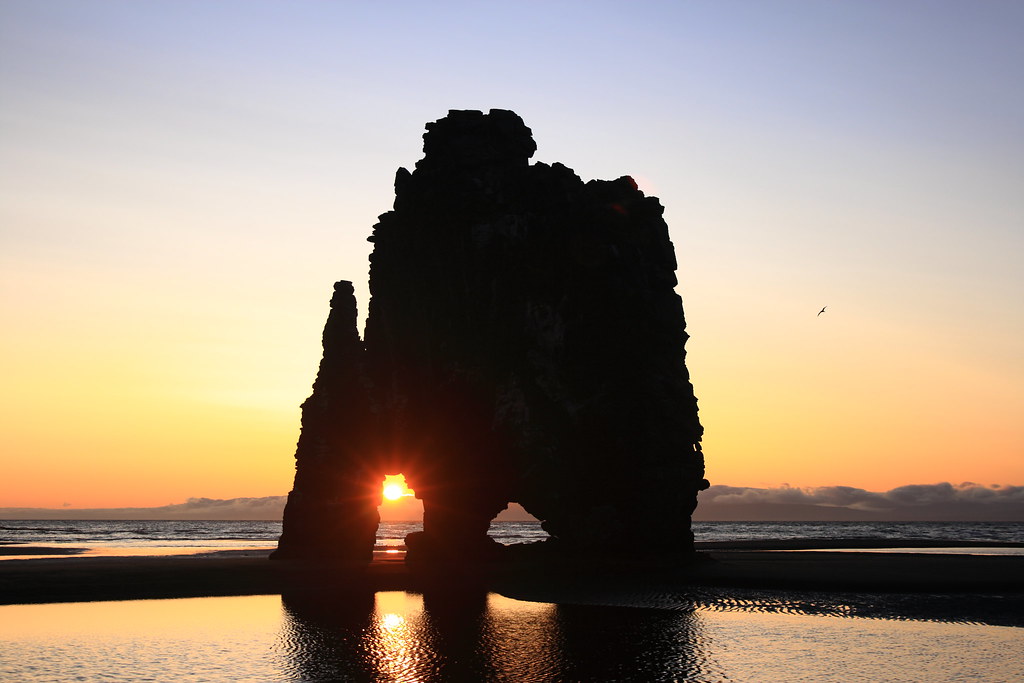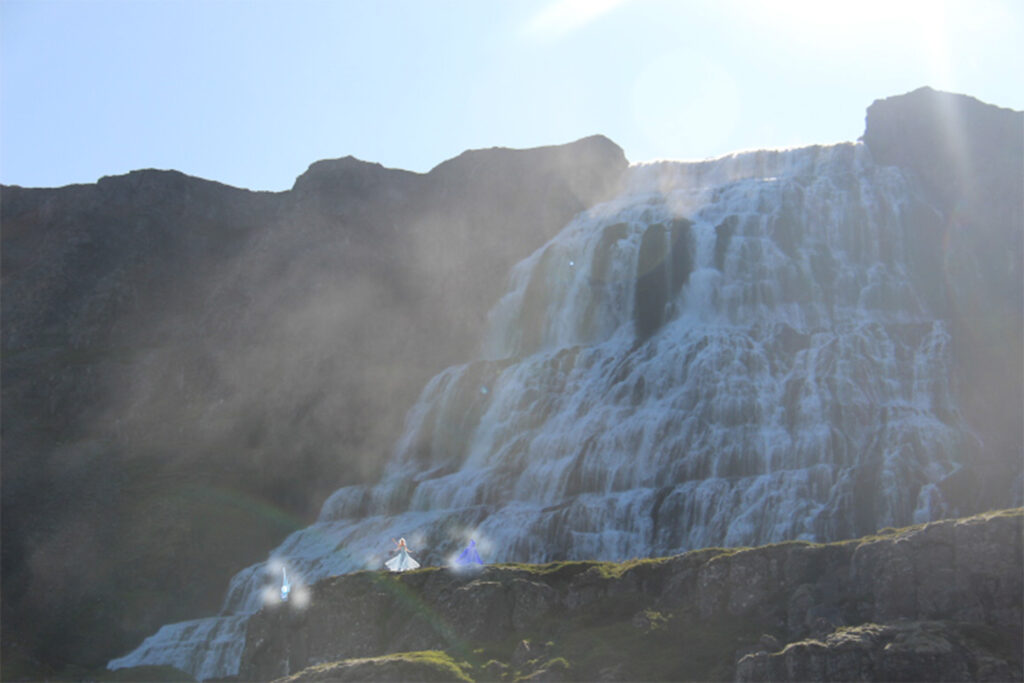
Halley Hughes

Halley Hughes
The following story has no known origin. Rather it was handed down from storyteller to storyteller. Traditionally, this story was told orally, likely huddled around sheep in a turf house when the winter winds blew. It is retold here for you in writing.
Hvítserkur (Ke-veet-sir-kur) was a giant troll who lived at Mount Bæjarfell (Bye-yar-fet). One night, he was jolted awake from his sleep by an obnoxious ringing noise: a clanging church bell. Hvítserkur knew that humans were making this sound — it was the men who had recently sailed to Iceland. Weeks and weeks went by, with Hvítserkur’s sleep remaining broken because of midnight bells being rung by the men across the fjord. Night after night, the sounds only got worse. It was particularly bad around winter, which was the giant’s favorite time of year. Hvítserkur had had enough! To stop the awful noise, Hvítserkur would travel to that house and destroy the bell once and for all.
Trolls despised the light of day, turning to stone upon its arrival. Hvítserkur was no exception. He decided to make the journey one evening, believing that he would make it to the bell before the following dawn. Unfortunately, the fjord waters were deep and treacherous, making it very difficult to cross. Hvítserkur walked and walked and then he began to run…. but the day was quickly looming. Hvítserkur was still sure they could get to the house on time and break the bell before daybreak.
As he stepped over the mountain and into the sea, he looked eastward, just in time to see the sun rising. Instantly, he began turning to stone. Hvítserkur felt this happening, and with the last of his strength he sent his hammer….woooOOOSH. THUMP. A last-ditch attempt to destroy the bell by throwing his hammer at the building that housed it. However, he failed, as he heard the hammer hit stone and not the wooden house.
His body still stands over the Vatnsnes (Vat-ne-snes) peninsula, in northwest Iceland as a giant boulder in the sea. It is believed that the hammer can be seen today in the eastern part of Þingeyrarsand, which can be accessed by visitors to this day.

Iceland is known around the world and amongst its residents as a “land of storytellers”. The first settlers of Iceland faced unimaginably harsh conditions. From unpredictable volcanic eruptions to freezing seas, and barren, infertile lands, early Icelanders were incredibly busy just staying alive. And yet, medieval Icelanders took the time to inscribe stories on precious calf hides that described the challenges and many facets of life that their people experienced on a daily basis.
“Storytelling and the environment, it’s part of who we are,” said Ragna Arnisdottir, the Secretary General of the Althingi, the Icelandic Parliament. Carried through centuries of oral and written storytelling is the Icelandic spirit of resilience, connection to the environment, and respect for nature. You may have heard of the Sagas, which is an Old Norse word that refers to the epic prose narratives written in Iceland between the 12th and 15th centuries. The stories’ contents were diverse, covering the country’s history as well as legendary tales of ancient Scandinavia.

“Mountains became trolls, lava fields became ghosts, and elves lived in all the creepy and dangerous spots in between,” said Aðalheiður Guðmundsdóttir (A-thal-hey-dur Guth-munds-dott-er), Ph.D., professor of medieval Icelandic literature at the University of Iceland.
“Why is it incorporated that way?” I asked.
“Well… if there is a dangerous place, for example, children to be…then we have legends about elves that are vengeful and will take the children…” Guðmundsdóttir said.
“Oh! I do think that’s a constant among cultures though… to use folktales to tell lessons… but in Iceland, it seems it’s so deeply connected to the environment,” I said.
“Yes, absolutely, that is something that is so unique to Iceland,” Guðmundsdóttir said.
Nowhere is the Icelanders’ historical connection to the environment more apparent than in the þjóðsögu (thee-yo-su-goo), or folktales of Iceland. According to the writings of Guðbrandur Vigfússon, (Guth-brand-ur Vick-fu-sson) an 18th-century Scandinavian scholar, the Sagas and the þjóðsögu are ‘twin sisters’ as the folktales have risen and grown in the company of each other. These stories teach lessons about how to navigate a world of danger and change, which brings the struggles of medieval Icelanders closer to our modern-day lives as climate change adds increasing environmental stress onto our bodies and communities. What can we learn from medieval Icelanders about courage, inventiveness, and solutions?
The þjóðsögu tell stories about the famous Huldufólk (Hool-du-foth), or Hidden People, which are best understood today as elves. These stories interweave the lived experience of medieval Icelanders with ancient wisdom and a little bit of magic. “Almost every hillock and boulder in the Icelandic landscape has its own story,” writes Olina Thorvardardottir, author of Spirits of the Land. The þjóðsögu were particularly effective in communicating the danger of nature to children. When boulders in the distance could hide elven tricksters or awaken as fearsome trolls, you’d stick closer to your parents too.

Guðmundsdóttir analyzes literature by looking at the language of stories. She uses an analogy to explain this. “When you are learning words, you don’t learn whole words, first you learn the letters. Eventually, those build into words. Then you combine words and suddenly you’re learning about sentences. Stories all have fundamental building blocks that you can study just as you would study the structure of poetry or sentences.”
“Do you think most people see stories in building block form?” I asked.
“Oh no… not really…probably just those who pay too much attention. But it’s a shame because it really is so important. And people use… story-blocks every day,” Guðmundsdóttir said.
“[Stories are] a necessary language because we have the need to express [our] feelings and opinions. If we didn’t have stories, we would all need to go… to the psychiatrist… it’s so basic! We all need to tell stories and hear stories. They will always be renewing themselves.”
However, the ancient art of storytelling faces one catastrophic foe: the modern audience’s attention span. Guðmundsdóttir notices the differences between audiences in ancient Iceland and today. “The story world I know, it’s much slower than what [modern audiences] want. Modern people try to make [Sagas and þjóðsögu] appealing,” she said. “What were [medieval Icelanders] able to listen to and find that we are not? Today you need more speed, you need more relatability, you need funny animal sidekicks.”
“Life moves pretty fast. If you don’t stop and look around once in a while, you could miss it.”
Ferris Bueller’s Day Off, dir. John Hughes.
The pace of storytelling remained relatively consistent over many centuries relative to the wants of media-consuming society at the time. Now, we’re seeing the ever-shortening attention span of the bombarded modern media consumer begin to accelerate nearly all storytelling at a breakneck pace. According to Guðmundsdóttir, “The question is, will we change with it or will we change [storytelling]…fundamentally.”
With climate change impacting every part of the globe, we need stories more than ever. Why? Stories communicate meaning and emotion, which are the essential ingredients needed to motivate people to act. People don’t easily relate to issues, they relate to other people — in other words, to their stories. Science supports the cognitive power of storytelling — showing that stories that elicit empathy in the audience have strong correlations with oxytocin releases in the brain which researcher Paul Zak calls, “the neurologic substrate for the Golden Rule.” By promoting reciprocity, story itself is the very fabric of connection.
“If you as a [climate] storyteller want to compete with the media, for the attention of people, it’s a question of if you want to go to the level of the media…which is speed and grandeur and fear. Or are you allowed to go back in time? Are you allowed to transport people back to an ancient structure that has followed us since the start of time,” Guðmundsdóttir said.
“Yeah,” I said.
“For example, I watched Laurence of Arabia… an old movie… and I thought ‘There is nothing happening here! It’s so slow,’” Guðmundsdóttir said. “And I thought, ‘Should I even continue?’ But when it was first shown [in theaters], people loved it!”
“Yes… I feel like people like the fast pace because we’re used to it, or it makes us feel good… but how much of that media are we actually remembering?” I said.
“Right, right,” she said.
As we ended our conversation, I said, “I would love to see things be slower and more intentional… and I mean we don’t have to put all the media there, but when things are really important and really connected to your emotions… this older way… that could be so powerful.”

Spending time in Iceland demonstrated to me the power of “slow” storytelling. This concept is a relative of other popular “slow” trends like “slow living” and “slow creating.” Slow storytelling invites listeners to give their full attention to the creation of the story world — no chopping potatoes while listening to NPR. Slow storytelling allows for details to unfold, allowing the storyteller to tie and untie the knot — of plot — at a speed that doesn’t try to match TikTok, Reels, scrolling feeds, or snappy news apps.
The history of slow Icelandic storytelling has been shaped by the landscapes and people those tales were about. Life on the island has long been dictated by freezing inky black winters, where stories and art were the only connection to the warmth of spring and gentler times. The intimate bonds that early Icelandic settlers nurtured lent themselves to stories that took the time to embed themselves in all of the people, places, and events of the time. Iceland’s deep connection to the environment has created stories that imbue respect and even stoke fear of the landscape they inhabit.
The þjóðsögu, like the tale of Hvítserkur above, shows how a return to slow, intentional stories can transform how humanity views nature and itself.
“I believe we can’t go back to dead traditions, but we can certainly make new things out of the old,” Guðmundsdóttir said. “We must be able to go back to respecting nature and respecting slow speeds. I know we can find these solutions… because humanities’ stories have always been really in love with solutions.”
Editor’s Note: Lindblad Expeditions, our Planet Forward Storyfest Competition partner, made this series possible by providing winners with an experiential learning opportunity aboard one of their ships. All editorial content is created independently. We thank Lindblad Expeditions for their continued support of our project.